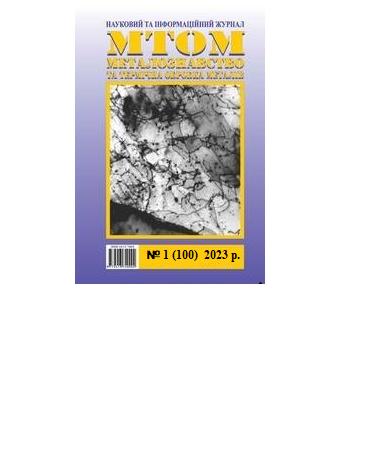REGULATIONS OF THE FORMATION OF BAINETIC COMPONENT MATRIX IN ECONOMY ALLOYED CHROMO-MANGANESE ALLOYS
DOI:
https://doi.org/10.30838/J.PMHTM.2413.280323.73.947Keywords:
chromium-manganese cast iron, isothermal soaking, microhardness, hardnessAbstract
Purpose. The purpose of the investigation is to establish the regularities of the kinetics of supercooled austenite decomposition in the bainite temperature range (400−200 °C) in chromium-manganese cast iron for the development of thermal hardening regimes that increase the service life of products. Methodology. The object of the study are samples of research and industrial smelting of chrome-manganese cast iron containing 3,1 % carbon, 13,1 % chromium, and 15,75 % manganese. The study of the supercooled austenite decomposition kinetics was carried out by the dilatometric method in the temperature range of 400−200 °C, the study of the microstructure, phase composition, as well as the measurement of microhardness and hardness was carried out according to standard methods. Scientific novelty. The peculiarities of the supercooled austenite decomposition kinetics in the bainite temperature range (400−200 °С) in chromium-manganese cast iron were determined, the structure of the cast iron after aging consists of eutectic carbides Me (Cr, Mn, Fe)7C3, products of austenite decomposition, secondary carbides Me (Cr, Mn, Fe)7C3, Me (Cr, Mn, Fe)3C, as well as untransformed austenite in the amount of 70...75 %. The maximum hardness of the experimental cast iron was established during isothermal exposure at 350 °C for 35 hours. Practical value. The established regularities of the chromium-manganese cast iron structure formation and the determined and optimized temperature-time intervals of the supercooled austenite isothermal decomposition in cast iron are the basis for the development of heat treatment regimes to increase the strength, wear resistance of the material and the service life of its products.
Downloads
Published
Issue
Section
License
Authors that are published in this journal agree to follow the conditions:
Authors reserve the right to the authorship of his work and cede the right to the journal of first publication of this work on conditions of the license under the Creative Commons Attribution License, which allows others to distribute it freely with the obligatory reference to the author of the original work and the first publication of the work in this journal.

